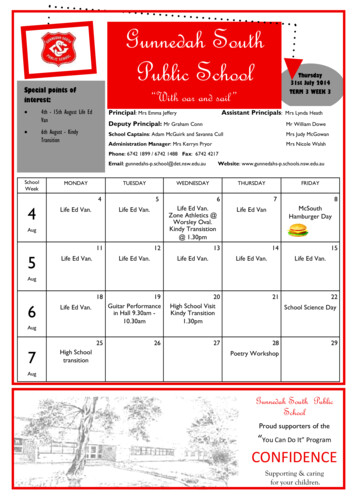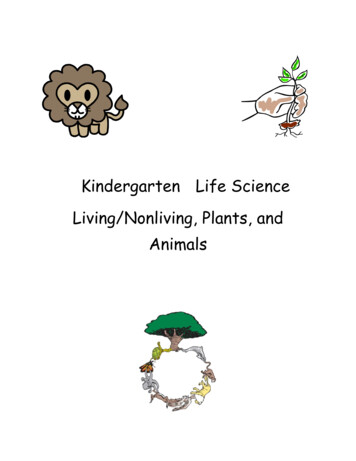
Transcription
Also by Dr. Wayne W. DyerBOOKSBeing in BalanceEveryday WisdomEveryday Wisdom for Success
Getting in the Gap (book-with-CD)Incredible You! (children’s book withKristina Tracy)InspirationThe Invisible ForceIt’s Not What You’ve Got (children’sbook with Kristina Tracy) Manifest YourDestinyA Morning and Afternoon of Your LifeNo More Holiday BluesThe Power of IntentionA Promise Is a PromisePulling Your Own StringsReal MagicThe Sky’s the LimitStaying on the Path10 Secrets for Success and Inner PeaceThere’s a Spiritual Solution to EveryProblemUnstoppable Me! (children’s book with
KristinaTracy) What Do You Really Wantfor Your Children?Wisdom of the AgesYou’ll See It When You Believe ItYour Erroneous ZonesYour Sacred SelfYour Ultimate CallingAUDIO/CD PROGRAMSApplying the 10 Secrets for Success andInner Peace Change Your Thoughts—ChangeYour Life (unabridged 8-CD set)Change Your Thoughts MeditationEveryday Wisdom (audio book)Freedom Through Higher AwarenessHow to Be a No-Limit Person How toGet What YouReally, Really, Really, Really WantIf You Change the Way You Live, the
Life You AreLiving Will Change(abridged 4-CD set)Inspiration (abridged 4-CD set)Inspirational ThoughtsThe Keys to Higher AwarenessMaking Your Thoughts Work for You(with ByronKatie) Meditations for ManifestingA Morning and Afternoon of Your Life(abridged 4-CD set) 101 Ways toTransformYour Life (audio book) The Power ofIntention (abridged 4-CD set) APromise Is a Promise(audio book) The Secrets of the Powerof Intention(6-CD set) 10 Secrets for Success andInner PeaceThere Is a Spiritual Solution to Every
Problem TheWayne Dyer Audio Collection/CDCollection YourJourney to Enlightenment (6-tapeprogram)VIDEOCASSETTESCreating Real Magic in Your LifeHow to Be a No-Limit PersonThe Miracle Mindset10 Secrets for Success and Inner PeaceWhat Do You Really Want for YourChildren?MISCELLANEOUSEveryday Wisdom Perpetual FlipCalendarInner Peace CardsInspiration CardsInspiration Perpetual Flip CalendarThe Power of Intention Cards ThePower of Intention
Perpetual Flip Calendar 10 Secrets forSuccess andInner Peace Cards10 Secrets for Success and Inner Peacegift products:Notecards, Candle, and JournalAll of the above are available at yourlocal bookstore,or may be ordered by visiting:Hay House USA: www.hayhouse.comHay House Australia:www.hayhouse.com.auHay House UK: www.hayhouse.co.ukHay House South Africa:orders@psdprom.co.zaHay House India: www.hayhouse.co.in
Copyright 2007 by Wayne W. DyerPublished and distributed in the United States by: Hay House,Inc.: www.hayhouse.com Publishedand distributed in Australia by: Hay House Australia Pty. Ltd.:www.hayhouse.com.au Published anddistributed in the United Kingdom by: Hay House UK, Ltd.:www.hayhouse.co.uk Published anddistributed in the Republic of South Africa by: Hay House SA(Pty), Ltd.: orders@psdprom.co.za Distributed in Canada by: Raincoast:
www.raincoast.com Published in India by: Hay House PublishersIndia: www.hayhouse.co.inWayne Dyer’s editor: Joanna PyleEditorial supervision: Jill Kramer Design: Amy Rose GrigoriouAll rights reserved. No part of this book may bereproduced by any mechanical, photographic, orelectronic process, or in the form of a phonographicrecording; nor may it be stored in a retrieval system,transmitted, or otherwise be copied for public orprivate use—other than for “fair use” as briefquotations embodied in articles and reviews—withoutprior written permission of the publisher.The author of this book does not dispense medicaladvice or prescribe the use of any technique as a formof treatment for physical, emotional, or medicalproblems without the advice of a physician, eitherdirectly or indirectly. The intent of the author is only to offerinformation of a general nature to help you inyour quest for emotional and spiritual well-being. In the event youuse any of the information in this book foryourself, which is your constitutional right, the author and thepublisher assume no responsibility for your
actions.Library of Congre ss Cataloging-in-PublicationDataDyer, Wayne W.Change your thoughts, change your life : living thewisdom of the Tao / Wayne W. Dyer.--1st ed.,.p. cm.ISBN 978-1-4019-1184-3 (hardcover) -- ISBN 9781-4019-1750-0 (pbk.) 1. Laozi. Dao de jing. I. Title.BL1900.L35D94 2007299.5’1482--dc222007000532ISBN: 978-1-4019-1184-310 09 08 07 4 3 2 11st edition, August 2007Printed in the United States of America
ContentsPreface. Verse Number:1 Living the Mystery2 Living the Paradoxical Unity3 Living Contentment4 Living Infinitely5 Living Impartially6 Living Creatively7 Living Beyond Ego8 Living in the Flow
9 Living Humility10 Living Oneness11 Living from the Void12 Living with Inner Conviction13 Living with an Independent Mind14 Living Beyond Form15 Living an Unhurried Life16 Living with Constancy17 Living as an Enlightened Leader18 Living Without Rules19 Living Without Attachment20 Living Without Striving21 Living the Elusive Paradox22 Living with Flexibility23 Living Naturally24 Living Without Excess25 Living from Greatness26 Living Calmly27 Living by Your Inner Light28 Living Virtuously
29 Living by Natural Law30 Living Without Force31 Living Without Weapons32 Living the Perfect Goodness of theTao33 Living Self-Mastery34 Living the Great Way35 Living Beyond Worldly Pleasures36 Living in Obscurity37 Living in Simplicity38 Living Within Your Own Nature39 Living Wholeness40 Living by Returning and Yielding41 Living Beyond Appearances42 Living by Melting into Harmony43 Living Softly44 Living by Knowing When to Stop45 Living Beyond Superficialities46 Living Peacefully47 Living by Being
48 Living by Decreasing49 Living Beyond Judgment50 Living as an Immortal51 Living by Hidden Virtue52 Living by Returning to the Mother53 Living Honorably54 Living as If Your Life Makes aDifference55 Living by Letting Go56 Living by Silent Knowing57 Living Without Authoritarianism58 Living Untroubled by Good or BadFortune59 Living by Thrift and Moderation60 Living with Immunity to Evil61 Living by Remaining Low62 Living in the Treasure-house of theTao63 Living Without Difficulties64 Living by Being Here Now
65 Living by Staying Simple-hearted66 Living by Emulating the Sea67 Living by the Three Treasures68 Living by Cooperating69 Living Without Enemies70 Living a God-Realized Life71 Living Without Sickness72 Living with Awe and Acceptance73 Living in Heaven’s Net74 Living with No Fear of Death75 Living by Demanding Little76 Living by Bending77 Living by Offering the Surplus78 Living like Water79 Living Without Resentments80 Living Your Own Utopia81 Living Without AccumulatingEpilogueAcknowledgmentsAbout the Author
PrefaceProgress is impossible without change,and those who cannot change theirminds cannot change anything.— George Bernard ShawChange Your Thoughts—Change YourLife is the end product of my yearlongjourney of research, contemplation, andapplication of the Tao Te Ching, a bookof wisdom that’s been translated morethan any volume in the world, with theexception of the Bible. Many scholarsconsider this Chinese classic theultimate discourse on the nature ofexistence; and it continues to be avaluable resource for achieving a way oflife that guarantees integrity, joy, peace,and balance. I recently read aboutsomeone who overcame life-threateningaddictive behaviors by reading and
rereading the 81 verses of this ancienttext. Just imagine! In fewer than 100short passages, it describes a way ofliving that’s balanced, moral, andspiritual; and that works for all facets oflife on Earth.Legend tells us that the Tao Te Chingwas authored by Lao-tzu, a prophet whowas also the keeper of the imperialarchives in the ancient capital ofLuoyang. Seeing the continual decayduring a period of warring states, Laotzu decided to ride westward into thedesert. At the Hanku Pass, a gatekeepernamed Yin Hsi, knowing of Lao-tzu’sreputation for being a man of wisdom,begged him to record the essence of histeaching. Thus, the Tao Te Ching wasborn out of 5,000 Chinese characters.In all my reading on the origins of the
Tao Te Ching, I never found a definitivehistorical record of its writing . . . yettoday it survives in thousands ofversions in virtually every language. Infact, after reading this classic text onemorning and then taking in a differentinterpretation that afternoon, I washooked. I ordered more translations, fiveof which were quite old and five ofwhich were more modern (you’ll findtheir titles in the Acknowledgments).Since neither Lao-tzu nor the origins ofhis verses are historically certain, I wasfascinated by the different ways the5,000 characters were interpreted byscholars in the editions I studied—especially when you consider that manyof these ancient Chinese symbols are nolonger in use and invite differingtranslations themselves.
I then felt called upon to write anessay for each verse that showed itsvaluable wisdom applied to the 21stcentury. From those ten translations I’dgone over, I pieced together the 81passages in Change Your Thoughts—Change Your Life, based on how theyresonated with me. This book is mypersonal interpretation of the Tao TeChing, each verse of which gave me aninsight into life and nature. As you readon, know that these pages were pastedtogether from what I personally feltwere the most useful aspects of those tendifferent translations I studied, and Iapologize for any exclusions (or if theinclusions don’t seem to be a perfect fit).One of the many gifts of the Tao TeChing is its mind-stretching quality,especially in the way that Lao-tzu uses
irony and paradox to get you to look atlife. If you think that being forceful is theappropriate response, Lao-tzu urges youto see the value in being humble. Ifaction seems called for, he asks you toconsider nonaction. If you feel thatgrasping will help you acquire what youneed or want, he counsels you to let goand be patient.And just what is this thing called “theTao”? As we’re told in the 1st verse, toname it is to lose it, so here’s the bestthat I can come up with: The Tao is thesupreme reality, an all-pervasive Sourceof everything. The Tao never begins orends, does nothing, and yet animateseverything in the world of form andboundaries, which is called “the worldof the 10,000 things.”Commentaries on the Tao Te Ching
generally interpret Tao as “the Way,” Teas “the shape and power” (that is, howthe Tao manifests), and Ching as“book.” Every translation I read referredto the Tao as the Way with a capital W,and Te as adding light or color to theWay. Well, as I look at the name I’vecarried with me for over 65 years,Way ne Dyer, I realize what may haveattracted me to studying and writingthese essays! As you can see, the firstthree letters of my name make up theword Way, while a dyer is one who addslight or color. It’s no wonder why I’vebeen so totally involved in reading,writing, interpreting, and, mostsignificantly, putting into practice these81 verses.In The Wisdom of China and India,Dr. Lin Yutang states, “If there is one
book in the whole of Oriental literaturewhich should be read above all others, itis, in my opinion [Lao-tzu’s] Book ofTao. . . . It is one of the profoundestbooks in the world’s philosophy . . .” Asyou read Change Your Thoughts—Change Your Life, you’re going to findyour way through Lao-tzu’s mystical andpractical philosophy, along with the joyof applying it to your life in today’smodern world.Writing this book was a completesurrender to ideas that didn’t alwaysseem to fit a linear rational approach,and it has changed me in a way that’slike the Tao itself: unexplainable andunnameable. Once I knew that I’d bespending a year on this project, itscreation came about in the followingway, which I have journaled for you:
I awake before 4 a.m.,meditate, consume juicesand supplements, and entermy sacred writing space.On a table, I have someframed drawings of Laotzu: In one he’s clad insimple robes, in anotherhe’s standing with a staff,and in a third he’s astridean ox. I ease into my workand read one verse of theTao Te Ching, letting thewords stay with me andinviting the forces of boththe outer and the inner lifeto inform me.Some of the passagescontain ideas that seem tobe directed to political
leaders—yet in all cases Ikeep the average reader inmind. In other words, I seekthe wisdom for everyone,not just for those inpositions of government orbusiness.I jot down a few notes,and for the next three daysI think about what Lao-tzuis offering. I invite the Taoto be with me throughoutthe day in all my activitiesas a background to the titleof this book. “Change yourthoughts, Wayne,” I tellmyself, “and watch howyour life changes.” And mythoughts do change.I feel the Tao with me,
always there, always doingnothing, and alwaysleaving absolutely nothingundone. As I’m now Seeingwith a capital S, thelandscape looks different.The people I See are godlycreations who are ignoringtheir own nature, or evenmore poignantly, needilyinterfering in the affairs ofothers. I have a differentperspective now: I feelmore peaceful and patient.I keep being reminded ofthe cyclical nature of theworld of the 10,000 thingsand have powerful insightsthat change what I see. Iknow that we humans are
like the rest of the naturalworld and that sadness,fear, frustration, or anytroubling feeling cannotlast. Nature doesn’t createa storm that never ends.Within misfortune, goodfortune hides.Following my days ofthinking and then applyingthe wisdom of a particularverse, I look into the eyesof Lao-tzu’s picture in theearly morning, and Iwonder, What did youmean? How does this applyhere, today, to anyone whomight want to liveaccording to these majesticteachings?
What happens next ismind-blowing in that itsimply comes. Through theages, through theatmosphere, through mypurple pen and onto thepage, flows what I can onlycall automatic writing. Iknow I don’t own it. I knowI can’t touch it, feel it, seeit, or even name it, but thewords arrive in the world ofthe 10,000 things. I amgrateful, bewildered,astonished, and overjoyed.The next day I beginanother four-day adventurewith this wisdom a Chinesemaster recorded 2,500years ago, feeling so
blessed, honored, andcompletely awestruck bythe profound impact thesewords have on me.It’s my vision that in this 21st century,our world must recruit future leaderswho are steeped in the importance ofLao-tzu’s words. Our survival maydepend on understanding that theconcepts of “enemy” and “war” cancease to exist through living Taocentered lives. Government will need toretreat from regulating our personallives, overly taxing our income, andinvading our privacy.Yet the lessons and truths of the Taomust be discovered and applied byindividuals. In this way, it can bring youto the enormous wonder of your ownbeing—yes, you are the Tao at work.
Your Preface being came from, and willreturn to, nonbeing. So for maximumenjoyment and benefit, make reading thisbook a personal journey. First peruseone of the passages of the Tao Te Chingand the essay that follows it. Next, spendsome time applying it, changing the wayyou’ve been conditioned to think andletting yourself open up to a new way ofconceptualizing these ideas. Finally,individualize the verse by writing,recording, drawing, or expressingyourself in whatever way you’re calledto. And move on to the next verse with arhythm that suits your nature.The following is from 365 Tao: DailyMeditations by Deng Ming Dao, which Ilove to turn to each day. Read thisexcerpt and see the Tao coming alive inyou:
If you spend a long periodof time in study and selfcultivation, you will enterTao. By doing so, you alsoenter a world ofextraordinary perceptions.You experienceunimaginable things, receivethoughts and learning as iffrom nowhere, perceivethings that could beclassified as prescient. Yetif you try to communicatewhat you experience, thereis no one to understand you,no one who will believeyou. The more you walk thisroad, the farther you arefrom the ordinary ways ofsociety. You may see the
truth, but you will find thatpeople would rather listento politicians, performers,and charlatans.If you are known as afollower of Tao, people mayseek you out, but they areseldom the ones who willtruly understand Tao. Theyare people who wouldexploit Tao as a crutch. Tospeak to them of thewonders you have seen isoften to engage in a futilebout of miscommunication.That is why it is said thatthose who know do notspeak.Why not simply stayquiet? Enjoy Tao as you
will. Let others think you aredumb. Inside yourself, youwill know the joy of Tao’smysteries. If you meetsomeone who can profit byyour experience, you shouldshare. But if you are merelya wanderer in a crowd ofstrangers, it is wisdom to besilent.Perhaps the overriding message of theTao Te Ching is to learn how to luxuriatein the simplicity of what you’re beingtold throughout this ancient sacred text.As you put its ideas into practice, you’lldiscover how profound it all is—butthen you’ll find yourself startled by itssimplicity and naturalness. The adviceof this ancient master is so easy to applythat you mustn’t try to complicate it.
Simply allow yourself to stay inharmony with your nature, which can betrusted if you just listen and actaccordingly.I hope that you’ll feel joyously in lovewith Lao-tzu and his wondrous Tao TeChing, and that you’ll add your light andcolor to the Great Way. I offer you mylove, along with my commitment to aTao-centered world. I can think of nogreater vision for you, for our planet, orfor our universe.— Wayne W. DyerMaui, Hawaii(Editor’s note : Lao-tzu’s name has been spelledmany different ways over the years, so in order toavoid confusion in this book, we’ll be using the spelling preferred byMerriam-Webster’s CollegiateDictionary, 11th Edition. )Of birds
I know that theyhave wings to fly with,of fish that they have fins toswim with, of wild beasts thattheyhave feet to run with. For feetthere are traps,for fins nets, for wings arrows.But who knows how dragonssurmount wind and cloudinto heaven? This day I haveseen[Lao-tzu] and he is a dragon.— from The Way of Life According toLao Tzu, translated by Witter Bynner(This quote is attributed to Confucius, after he visited the elder Laotzu to seek advice on points ofceremonial etiquette.)1st VerseThe Tao that can be toldis not the eternal Tao.
The name that can be namedis not the eternal name.The Tao is both named and nameless.As nameless it is the origin of allthings;as named it is the Mother of 10,000things.Ever desireless, one can see themystery;ever desiring, one sees only themanifestations.And the mystery itself is the doorwayto all understanding.Living the MysteryIn this opening verse of the Tao TeChing, Lao-tzu tells us that the “Tao isboth named and nameless.” This soundsparadoxical to our Western intellect—and it is! Paradoxical thinking is
embedded in Eastern concepts such asyin and yang or the feminine and themasculine, and where things arecomfortably described as both this andthat. We in the West, by contrast, tend toview opposites as incompatibleconcepts that contradict each other. Yetthis book is asking that we change ouringrained ways of thinking and see howour lives change as a result.The Tao is an unknowable, unseeablerealm where everything originates;while at the same time, the Tao isinvisibly within everything. When wedesire to see this invisibleness(mystery), we attempt to define it interms of the outer world of form—whatLao-tzu calls “the 10,000 things.” Hecounsels us that letting go of trying to seethe mystery will actually allow us to see
it. Or, as I like to think of it, “let go andlet God.” But how can we do that? Oneway is to permit ourselves to practicemore paradoxical thinking byrecognizing that desiring (wanting) anddesireless (allowing) are different andthe same . . . rather like the mysteriousends of a continuum.Desiring is the physical expression ofcreating conditions that allow us to bereceptive; that is, it’s in-the-worldpreparation for receiving. According toLao-tzu, wanting to know or see themystery of the Tao will reveal evidenceof it in a variety of manifestations, butnot the mystery itself. But this isn’t adead end! From this ground of desiring,the flowering of the mysterious Taogrows. It’s as if wanting transforms intoeffortless allowing. Desiring, one sees
the manifestations; desireless, one cansee the mystery itself.When we tune in to what Lao-tzu istelling us, it becomes readily apparentthat our world produces abundantexamples of this paradoxical process.Think of gardening and desiring thoseluscious homegrown tomatoes or springdaffodils: Allowing them to grow isultimately what happens. Now think ofthe things in life that involve wantingand how they differ from allowing:Wanting to go to sleep, for instance,rather than going to sleep. Wanting todiet, rather than dieting. Wanting to love,rather than loving. In this reference to theTao, desireless means trusting,permitting, and allowing. Desire is boththe beginning and the ground ofdesirelessness, yet wanting is also the
beginning and the ground of allowing.They are the same, and they aredifferent.Pay attention to times when you canfeel in your body where you are on thecontinuum between desiring andallowing (or trying and doing). Trying toplay the piano, drive the car, or ride thebicycle is the same as, and differentfrom, actually playing the piano, drivingthe car, and riding the bicycle. Oncethose outer-world activities are desiredand learned, there’s a time whenallowing is what you do. The point hereis to recognize the difference in yourbody between trying and allowing, andto then become aware of the effortlesssensation of the latter. This practice willalso lead to a greater awareness of theinvisible mystery and the 10,000 things,
which are the visible phenomena of ourworld.The 10,000 things that Lao-tzu refersto represent the categorized, classified,and scientifically named objects of theearth, which help us communicate andidentify what we’re talking and thinkingabout. Yet for all our technologicalexpertise and scientific categorization,we can never truly create a human eye orliver, or even a grain of wheat for thatmatter. Each of these things—along withthe remainder that comprise the knownor named world—emerge from themystery, the eternal Tao. Just as theworld is not its named parts, we’re notexclusively the skin, bone, and rivers offluids that we’re physically made of.We, too, are the eternal Tao, invisiblyanimating our tongues to speak, ears to
hear, and eyes to see and experience themanifest and the mystery. Consciouslyallowing this nameless mystery isultimately the way to practice the Tao.Does that mean putting yourself inharm’s way? Of course not. Does thatmean trusting the mystery at the momentyou’re being mugged or mistreated?Probably not. Does it mean never tryingto change things? No. It does meancultivating a practice of being in themystery and allowing it to flow throughyou unimpeded. It means permitting theparadox of being in form at the sametime that you allow the mystery tounfold.Do the Tao; find your personal waysof living in the mystery. As Lao-tzu saysin this 1st verse, “And the mystery itselfis the doorway to all understanding.”
Here’s my advice for translating thispassage into daily practice in this 21stcentury:First and foremost, enjoy the mystery!Let the world unfold without alwaysattempting to figure it all out. Letrelationships just be, for example, sinceeverything is going to stretch out inDivine order. Don’t try so hard to makesomething work—simply allow. Don’talways toil at trying to understand yourmate, your children, your parents, yourboss, or anyone else, because the Tao isworking at all times. When expectationsare shattered, practice allowing that tobe the way it is. Relax, let go, allow, andrecognize that some of your desires areabout how you think your world shouldbe, rather than how it is in that moment.Become an astute observer . . . judge
less and listen more. Take time to openyour mind to the fascinating mystery anduncertainty that we all experience.Practice letting go of always namingand labeling.The labeling process is what most ofus were taught in school. We studiedhard to be able to define things correctlyin order to get what we called “highgrades.” Most educational institutionsinsisted on identifying everything,leading to a tag that distinguished us asgraduates with knowledge of specificcategories. Yet we know, without anyonetelling us, that there is no title, degree, ordistinguishing label that truly defines us.In the same way that water is not theword water—any more than it is agua,Wasser, or H2O—nothing in thisuniverse is what it’s named. In spite of
our endless categorizations, each animal,flower, mineral, and human can nevertruly be described. In the same way, theTao tells us that “the name that can benamed is not the eternal name.” We mustbask in the magnificence of what is seenand sensed, instead of alwaysmemorizing and categorizing.Do the Tao NowAt some point today, notice aninstance of annoyance or irritation youhave with another person or situation.Decide to do the Tao (or practice theWay) in that moment by turning inwardwith curiosity about where you are onthe continuum between desire andallowing. Permit the paradox of wantingthe irritant to vanish and allowing it tobe what it is. Look inward for it in yourthoughts and allow yourself to feel it
wherever it is and however it moves inyour body.Turn all of your attention to becomingopen-minded, allowing permissivenessto befriend the mystery within yourself.Notice how the feeling manifests itself:perhaps doing “loop-de-loops” in yourstomach, giving a rigidness to yourskeleton, making your heart pound, ortightening your throat. Wherever it is,allow it as an enigmatic messengerwithin you, and give it nonjudgmentalattention. Notice the desire for thefeeling to disappear, and allow it to bemonitored compassionately by you.Accept whatever comes. Encounter themystery within without labeling,explaining, or defending. It’s a subtledistinction at first, which you must take
personal responsibility for identifying.You alone can prepare the ground ofyour being for the experience of livingthe mystery.2nd VerseUnder heaven all can see beauty asbeauty,only because there is ugliness.All can know good as good onlybecause there is evil.
Being and nonbeing produce eachother.The difficult is born in the easy.Long is defined by short, the high bythe low.Before and after go along with eachother.So the sage lives openly with apparentdualityand paradoxical unity.The sage can act without effortand teach without words.Nurturing things without possessingthem,he works, but not for rewards;he competes, but not for results.When the work is done, it is forgotten.That is why it lasts forever.Living the
Paradoxical UnityThe concept of something or someonebeing beautiful is grounded in a beliefsystem that promotes duality andjudgment. This way of thinking isprevalent and commonplace for justabout everybody in our culture, perhapseven having some value in society. Iencourage you to explore the concept ofparadoxical unity in this 2nd verse of theTao Te Ching. By changing yourthoughts, you can change your life andtruly live the bliss of oneness.Has it ever occurred to you that beautydepends on something being identifiedas ugly? Therefore, the idea of beautyproduces the idea of ugliness, and viceversa. Just think of how many conceptsin this “duality belief system” depend onopposites: A person isn’t tall unless
there’s a belief system that includesshort. Our idea of life couldn’t existwithout that of death. Day is the oppositeof night. Male is the antithesis of female.What if you instead perceived all as apiece (or a glimpse) of the perfection ofoneness? I think this is what Lao-tzu issuggesting with his description of thesage who “lives openly with apparentduality and paradoxical unity.” Imaginethe perfect oneness coexisting in theapparent duality, where opposites aresimply judgments made by human mindsin the world of 10,000 things. Surely thedaffodil doesn’t think that the daisy isprettier or uglier than it is, and the eagleand the mouse have no sense of theopposites we call life and death. Thetrees, flowers, and animals know not ofugliness or beauty; they simply are . . . in
harmony with the eternal Tao, devoid ofjudgment.As the sage lives openly withapparent duality, he synthesizes theorigin with the manifestation withoutforming an opinion about it. Livingwithout judgment and in perfect onenessis what Lao-tzu invites his readers to do.He invites our wisdom to combineperceived opposites and live a unifiedlife. The perfection of the Tao isallowing apparent duality while seeingthe unity that is reality. Life and deathare identical. Virtue and sin arejudgments, needing both to identifyeither. These are the paradoxes of aunified life; this is living within theeternal Tao. Once the dichotomies orpairs of opposites are transcended, or atleast seen for what they are, they flow in
and out of life like the tides.Practice being a living, breathingparadox every moment of your life. Thebody has physical boundaries—it beginsand ends and has material substance. Yetit also contains something that defiesboundaries, has no substance, and isinfinite and formless. You are both theTao and the 10,000 thingssimultaneously. Let the contrasting andopposite ideas be within you at the sametime. Allow yourself to hold thoseopposite thoughts without them cancelingeach other out. Believe strongly in yourfree will and ability to influence yoursurroundings, and simultaneouslysurrender to the energy within you.Know that good and evil are two aspectsof a union. In other words, accept theduality of the material world while still
remaining in constant contact with theoneness of the eternal Tao. Thedebilit
Also by Dr. Wayne W. Dyer BOOKS Being in Balance Everyday Wisdom Everyday Wisdom for Success. Getting in the Gap (book-with-CD) Incredible You! (children's book with Kristina Tracy) . Wayne Dyer Audio Collection/CD Collection Your Journey to Enlightenment (6-tape program) VIDEOCASSETTES Creating Real Magic in Your Life



![Change Management Process For [Project Name] - West Virginia](/img/32/change-20management-20process-2003-2022-202012.jpg)







